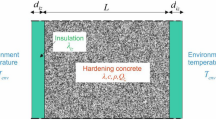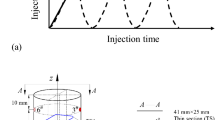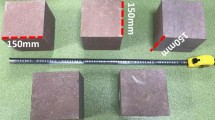Abstract
In this paper, new models of the density and modulus development of concrete under continued hydration were studied. Experimental study was performed for different mixes of concrete. To avoid considering the effect of variation of Poisson’s ratio, the one-dimensional ultrasonic technique was adopted to detect the modulus development of concrete under continued hydration. The experimental results indicate the nonlinear characteristics of density and modulus evolution. At the initial stage of continued hydration, the density and modulus increase quickly, and then the increases slow down and finally tend to be constant. The mechanism of modulus enhancement is that the newly produced C–S–H gel in the continued hydration process not only leads to the decrease in porosity, but also repairs the initial defects of concrete. Based on this mechanism, simple differential equations for the density and modulus development of concrete were established by considering the chemical reactions of continued hydration, and new simple models for density and modulus development were proposed.










Similar content being viewed by others
Change history
22 November 2018
In all the articles in Acta Mechanica Solida Sinica, Volume 31, Issues 1–4, the copyright is incorrectly displayed as “The Chinese Society of Theoretical and Applied Mechanics and Technology ” where it should be “The Chinese Society of Theoretical and Applied Mechanics”.
References
Al-Amoudi OSB. Attack on plain and blended cements exposed to aggressive sulfate environments. Cement Concrete Compos. 2002;24(3–4):305–16.
Lee ST, Moon HY, Swamy RN. Sulfate attack and role of silica fume in resisting strength loss. Cement Concrete Compos. 2005;27(1):65–76.
Bakharev T, Sanjayan JG, Cheng YB. Sulfate attack on alkali-activated slag concrete. Cement Concrete Res. 2002;32(2):211–6.
Chen JK, Qian C, Song H. A new chemo-mechanical model of damage in concrete under sulfate attack. Constr Build Mater. 2016;115:536–43.
Ouyang WY, Chen JK, Jiang MQ. Evolution of surface hardness of concrete under sulfate attack. Constr Build Mater. 2014;53(2):419–24.
Chen JK, Jiang MQ, Zhu J. Damage evolution in cement mortar due to erosion of sulphate. Corros Sci. 2008;50(9):2478–83.
Wilby CB. Concrete materials and structures. Cambridge: Cambridge University Press; 1991.
Bai J, Chaipanich A, Kinuthia JM, Farrell MO, Sabir BB, Wild S, et al. Compressive strength and hydration of wastepaper sludge ash-ground granulated blastfurnace slag blended pastes. Cement Concrete Res. 2003;33(8):1189–202.
Calvo JLG, Alonso MC, Hidalgo A, Luco F, Flor-Laguna V. Development of low-pH cementitious materials based on CAC for HLW repositories: long-term hydration and resistance against groundwater aggression. Cement Concrete Res. 2013;51(9):67–77.
Tittelboom KV, Gruyaert E, Rahier H, Belie ND. Influence of mix composition on the extent of autogenous crack healing by continued hydration or calcium carbonate formation. Constr Build Mater. 2012;37(37):349–59.
Grant SA, Boitnott GE, Korhonen CJ, Sletten RS. Effect of temperature on hydration kinetics and polymerization of tricalcium silicate in stirred suspensions of CaO-saturated solutions. Cement Concrete Res. 2006;36(4):671–7.
Bullard JW, Jennings HM, Livingston RA, Nonat A, Scherer GW, Schweitzer JS, et al. Mechanisms of cement hydration. Cement Concrete Res. 2011;41(12):1208–23.
Xi Y, Siemer DD, Scheetz BE. Strength development, hydration reaction and pore structure of autoclaved slag cement with added silica fume. Cement Concrete Res. 1997;27(1):75–82.
Bernard O, Ulm FJ, Lemarchand E. A multiscale micromechanics-hydration model for the early-age elastic properties of cement-based materials. Cement Concrete Res. 2003;33(9):1293–309.
Freidin C. Hydration and strength development of binder based on high-calcium oil shale fly ash. Part 2: influence of curing conditions on long-term stability. Cement Concrete Res. 1999;29(11):1713–9.
Mak SL, Torii K. Strength development of high strength concretes with and without silica fume under the influence of high hydration temperatures. Cement Concrete Res. 1995;25(8):1791–802.
Livingston RA. Fractal nucleation and growth model for the hydration of tricalcium silicate. Cement Concrete Res. 2000;30(12):1853–60.
Ohtsu M. Elastic wave methods for NDE in concrete based on generalized theory of acoustic emission. Constr Build Mater. 2016;122:845–54.
Chu HY, Chen JK. Evolution of viscosity of concrete under sulfate attack. Constr Build Mater. 2013;39:46–50.
Song H, Chen JK. Effect of damage evolution on Poisson’s ratio of concrete under sulfate attack. Acta Mech Solida Sin. 2011;24(3):209–15.
Meyers MA. Dynamic behavior of materials. Chichester: Wiley; 1994.
Stephan D, Dikoundou SN, Raudaschl-Sieber G. Hydration characteristics and hydration products of tricalcium silicate doped with a combination of MgO, \(\text{ Al }_{2}\text{ O }_{3}\), and \(\text{ Fe }_{2}\text{ O }_{3}\). Thermochim Acta. 2008;472(1–2):64–73.
Acknowledgements
The authors would like to acknowledge the financial support by the National Natural Science Foundation of China (NSFC #11772164, #11272165, #11572163), the National Basic Research Program of China (973 Program, 2009CB623203), the Key Research Program of Society Development of Ningbo (2013C51007), and the K.C. Wong Magna Fund in Ningbo University. The authors were also supported by the Research Project Foundation of Zhejiang Educational Department (Y201636745).
Author information
Authors and Affiliations
Corresponding author
Rights and permissions
About this article
Cite this article
Yu, L., Chen, J. & Song, H. Experimental and Theoretical Analyses on the Density and Modulus Development of Concrete Under Continued Hydration. Acta Mech. Solida Sin. 31, 161–173 (2018). https://doi.org/10.1007/s10338-018-0019-5
Received:
Revised:
Accepted:
Published:
Issue Date:
DOI: https://doi.org/10.1007/s10338-018-0019-5




